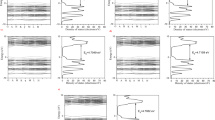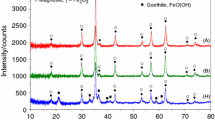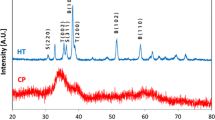Summary
-
1.
The densities of specimens of lower oxides of titanium in the composition range TiO0–0.560 were determined by a pycnometric method.
-
2.
Data on the densities and unit cell dimensions have been used to calculate the total number of atoms in the unit cell of the lower oxides of titanium and also the individual numbers of titanium and oxygen atoms.
-
3.
The α phase of the titanium-oxygen system is produced by the introduction of oxygen atoms (ions) into the holes in the α-titanium lattice.
-
4.
The intensities of the reflections in the powder diagrams of lower oxides of titanium have been studied and satisfactory agreement has been found between the theoretical and experimental intensities both for the α phase and for the oxide TiO0.451, assuming a statistical distribution of oxygen atoms (ions) in the octahedral holes of the α-phase.
-
5.
Analysis of the theoretical and experimental intensities of the reflections for specimens of titanium oxides TiO0.401–0.600 annealed for a prolonged period at 300° has shown that the oxygen atoms are arranged in ordered fashion in every second layer of octahedral holes, lying perpendicular to the z axis.
-
6.
With increase in the oxygen content of the oxides, the interatomic Ti−Ti, Ti−O, and O−O distances in the lower oxides of titanium increase smoothly and the packing of the titanium atoms approaches ideal hexagonal packing.
-
7.
The chemical character of the lower oxides of titanium has been discussed and it has been concluded that the α phase of the titanium-oxygen system is a chemical compound of variable composition.
Similar content being viewed by others
Literature cited
P. Ehrlich, Z. anorgan. and allgem. Chem.247, 53 (1941).
E. S. Bumps, H. D. Kessler, and M. Hansen, Trans. Am. Soc. Metals45, 1008 (1953).
A. D. McQuillan and M. K. McQuillan, Titanium (London, 1956).
S. Andersson, B. Collen, U. Kuylenstierna, and A. Magneli, Acta Chem. Scand.11, 1641 (1957).
S. M. Ariya, M. P. Morozova, and E. Vol'f, Zhur. Neorg. Khim.2, 1, 13 (1957).
M. P. Morozova, E. Vol'f, and T. P. Balova, Vestnik Leningradsk. Univ., 4; Ser. Fiz. i Khim.1, 78 (1959).
G. Grossman, Thesis [in Russian] (Izd, LGU, 1959).
L. M. Kuznetsov, E. S. Makarov, and Z. M. Turovtseva, Zhur. Anal. Khim.14, 4, 463 (1959). Original Russian pagination. See C. B. translation.
Z. M. Turovtseva and R. Sh. Khalitov, Zhur. Anal. Khim,7, 6, 720 (1957).
E. M. Bonshtedt-Kupletskaya, The Determination of the Specific Gravity of Minerals [in Russian] (Izd. AN SSR, Moscow, 1951).
H. P. Klug and L. E. Alexander, X-ray Diffraction Procedures for Polycrystalline and Amorphous Materials (New York-London, 1954). P. 376.
N. S. Kurnakov, Introduction to Physicochemical Analysis [in russian] (Izd. AN SSSR, Moscow-Leningrad, 1940).
E. S. Makarov, Zhur. Neorg. Khim.1, 9, 2032 (1956).
F. Weibke and O. Kubaschewski, Thermochemie der Legierungen (Berlin, 1943).
Author information
Authors and Affiliations
Additional information
Translated from Zhurnal Strukturnoi Khimii, Vol. 1, No. 2, pp. 170–177, July–August, 1960
Rights and permissions
About this article
Cite this article
Makarov, E.S., Kuznetsov, L.M. The crystal structure and chemical character of lower oxides of titanium TiO0→0.48. J Struct Chem 1, 156–162 (1960). https://doi.org/10.1007/BF00738933
Received:
Issue Date:
DOI: https://doi.org/10.1007/BF00738933




